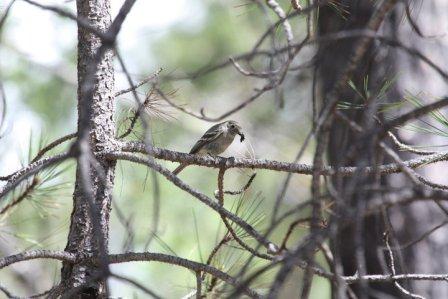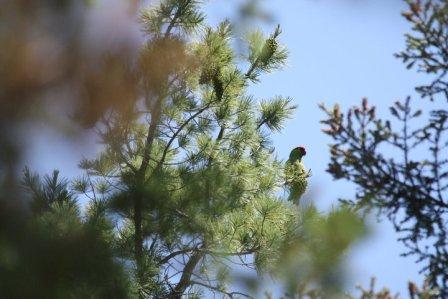Photos with this report (click to enlarge) | |||
 Pine Flycatcher |
 Thick-billed Parrot |
 Cordilleran Flycatcher |
|
This trip was mainly focused on conducting surveys in an area that has been poorly covered by both birders and researchers previously. The area is a high montane forest approximately 3000 m in elevation in the Sierra Madre Occidental of Chihuahua, part of the Refugio de Flora y Fauna ‘la Cotorra Serrana’ near the small town of Matachic. This area is very remote, approximately 5 hrs southwest from the main paved road, and hosts a healthy population of Thick-billed Parrots (Rhynchopsitta pachyrhyncha) as well as several other birds of high pine-fir forest.
LOGISTICS
The Refugio de Flora y Fauna ‘la Cotorra Serrana’ (older name: La Reserva Forestal Nacional y Zona de Refugio de la Fauna Silvestre Tutuaca) is located close to Babícora, approximately 5 hrs from the paved road near the town of Matachic, which in turn can be reached in 3 hrs from Chihuahua city. The road going to the reserve is not indicated, very rough and goes through several ejidos (townships), including the somewhat larger ejido of Tutuaca. It is recommendable, if this trip is undertaken to get local advice or guidance. The area is currently (JUN ’10) also only locally accessible due to the increasing crime by narcotraficantes. According to locals, several towns should not be visited by gringos due to increased risk of harassment, robberies, kidnapping and even murder. These include former tourist towns such as Madera, where birders visited to see Eared Quetzal and Thick-billed Parrot. At the Refugio, there are currently no facilities for visitors, camping is possible with previous permission from local authorities (CONANP, Cd. Chihuahua). A new cabin has just been built, but has not been opened to visitors yet due to legal constraints. If you do visit the area, be sure to leave some money and/or food with the people that maintain the park. They don’t get to do shopping regularly! Needless to say, pack food and water, bring a terrain vehicle and good camping gear. Be prepared for rainy weather in July and August, snow from November til March and sunny but cool weather otherwise.
The park holds large tracts of intact Sierra Madre pine-fir forest. Pinus ayacahuite is dominant and a favorite food source of the Thick-billed Parrots. Several other Pinus species abound, as well as spruce (Picea)in high wet areas, madrone (Arbutus, and several oaks Quercus. Habitat along creek sides seems especially suitable where there is dense gooseberry Ribes shrubbery. Some selective logging takes place, especially at lower elevations, but higher up the forest looks magnificent.
BIRDS
Good birds seen include Thick-billed Parrot, Pine Flycatcher, Spotted Wren, Flammulated Owl, Mountain Pygmy-Owl, Black Swift, Berylline Hummingbird, and Eastern (Azure) Bluebird. Unfortunately no Eared Quetzal (too xeric?), Sinaloa Martin (lucky shot) or Aztec Thrush (too early). Lower elevations were poorly covered, but seemed to hold good habitat. The area holds great potential without a doubt. The following is a list of species seen from lower elevations near Matachic up to over 3000m. Locations include the mentioned accommodations area in a large clearing, and two nearby valleys (one dominated by Pinus and Abies, the other by Pinus and Picea), as well as sightings along the road leading up to the reserve.
*Turkey Vulture - Cathartes aura aura – One or two each day.
*Cooper’s Hawk - Accipiter cooperii – One (22)
*Common Black-Hawk – Buteogallus anthracinus – A pair en route at lower elevation near Matachic.
*Red-tailed Hawk - Buteo jamaicensis (calurus?) – Two (19, 22)
*Thick-billed Parrot - Rhynchopsittaca pachyrhyncha – Daily, several. Approx 300 birds in the whole area, with over 100 nests in large old pines. Birds are easily seen flying over hill ridges, occasionally sitting in tree tops (a good sign: you can approach these birds fairly close, which might hint to limited hunting in the area).
*Flammulated Owl - Megascops (Otus) flammeolus – On the 20th, at 9pm, 3 were registered responding to taped calls. On the 21st, 4. Seems common in the area, especially around creeks and areas with dense soil vegetation.
*Mountain Pygmy-Owl - Glaucidium gnoma gnoma – One chasing American Robins in high valley with lots of Picea.
*Mexican Whip-poor-Will - Caprimulgus arizonae – Two heard each night, near edge of open forest.
*Black Swift - Cypseloides niger costaricensis?– June 22nd: two large swifts flying over clearing near campsite, no conspicuous white markings, presumably this species. Later that day one flying down creek, definite ID.
*White-eared Hummingbird - Hylocharis leucotis borealis– Several, even in highest mountains.
*Magnificent Hummingbird - Eugenes fulgens fulgens– Very common, only hummingbird in Picea-dominated areas.
*Berylline Hummingbird - Amazilia beryllina viola– Somewhat unexpected, one individual. This species does not usually range this far east, or this high.
*Broad-tailed Hummingbird - Selasphorus platycercus– Heard and seen on a few occasions, does not appear as common as e.g. in U.S. Rocky Mountains.
*Mountain Trogon - Trogon mexicanus clarus – At least 4 seen, many more heard.
*Hairy Woodpecker - Picoides villosus icastus – One pair observed.
*Northern Flicker - Colaptes auratus collaris – Abundant.
*Greater Pewee - Contopus pertinax pertinax – Common, in tops of pines.
*Western Wood-Pewee - Contopus sordidulus sordidulus – Heard only twice.
*Buff-breasted Flycatcher - Empidonax fulvifrons rubicundus – Common, sings during whole day, of the Empidonax in the region, seems most to prefer edges of openings or very open forest.
*Cordilleran Flycatcher – Empidonax occidentalis occidentalis – Locally common, near creeks and boulders in shady ravines.
*Pine Flycatcher - Empidonax affinis pulverius – Not terribly common, although probably somewhat overlooked by us, due to habitat preferences: it seemed to prefer rather dry, dense, young pine forest with lots of mosses.
*Dusky-capped Flycatcher - Myiarchus tuberculifer olivascens – One called.
*Violet-green Swallow - Tachycineta thalassina brachyptera – Small flocks regularly observed.
*Barn Swallow - Hirundo rustica erythrogaster – 2 in a group of Violet-greens.
*Steller’s Jay - Cyanocitta stelleri diademata – Abundant, especially in higher forests.
*Raven - Corvus corax sinuatus – Common.
*Mexican Chickadee - Poecile sclateri eidos – Abundant.
*White-breasted Nuthatch - Sitta carolinensis mexicana– Seems uncommon, 3 individuals heard.
*Pygmy Nuthatch - Sitta pygmaea chihuahuae – Saltapalos Enano – Seems uncommon, just 2, in pine closet o large clearing.
*Brown Creeper - Certhia americana– Family groups including young observed on occasion.
*Rock Wren - Salpinctes obsoletus obsoletus – Heard occasionally.
*Spotted Wren – Campylorhynchus gularis – Several seen lower elevations en route.
*House Wren or Brown-throated Wren - Troglodytes aedon cahooni –Pairs heard and seen regularly, characteristics seem to be of Brown-throated Wren.
*Western Bluebird - Sialia mexicana amabilis – Two in clearing every day.
*Eastern (Azure) Bluebird – Sialia sialia fulva - A few en route in clearing near ejido.
*Townsend’s Solitaire - Myadestes townsendi calophonus – Common, surprisingly no Brown-backed Solitaires, maybe too high?
*Russet Nightingale-thrush - Catharus occidentalis olivascens – Abundant, especially by voice. No other Catharus in region seemingly.
*American Robin - Turdus migratorius propinquus – Abundant.
*Plumbeous Vireo - Vireo plumbeus pinicolus – 2 birds, less common than further north in the U.S.
*Hutton’s Vireo - Vireo huttoni stephensi– One bird.
*Crescent-chested Warbler - Vermivora (Parula) superciliosa sodalis– Abundant, especially by its trilling call.
*Red-faced Warbler - Cardellina rubrifrons – Common, especially in wetter areas with gooseberry undergrowth.
*Painted Redstart - Myioborus pictus pictus – Just one bird.
*Slate-throated Redstart - Myioborus miniatus miniatus– Abundant.
*Olive Warbler - Peucedramus taeniatus arizonae?/jaliscensis? – Fairly common.
*Hepatic Tanager - Piranga (flava) hepatica– Common, especially in wet areas.
*Black-headed Grosbeak - Pheucticus melanocephalus melanocephalus – Just one bird, singing close to campsite.
*Spotted Towhee - Pipilo maculatus griseipygius – Common in shrubbery.
*Yellow-eyed Junco - Junco phaeonotus palliatus – Common.
OTHER ANIMALS
Southwestern Toad (Bufo mexicanus)
Lizard sp. (Sceloporus sp.)
Arizona Squirrel? (Sciurus arizonensis?)